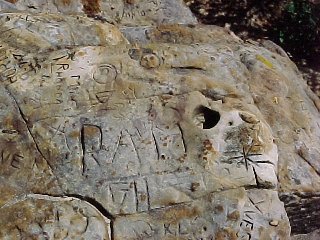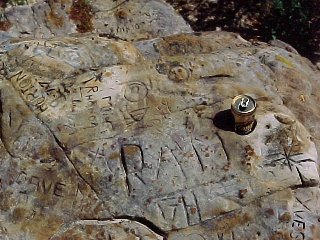Leaverites - Man-Made Features
Steven Dutch, Professor Emeritus, Natural and Applied Sciences, University of Wisconsin - Green Bay
Man-Made Coatings
| Don't overlook the possibility that a strange marking on a rock may be due to paint, asphalt, adhering concrete, oil, lime, fertilizer, or some other artificial material.
The white coating here is merely errant spray paint |
 |
Man-Made Markings
| Grooves and scratches on rock surfaces can be due to bulldozers, backhoes, logging cables, etc. Tires will leave black films on rocks.
Genuine glacial striations run from upper left to lower right in this picture. They are crossed by more recent scratches made by earthmovers. |
 |
 |
These grooves on Stone Mountain, GA look glacial, but the location argues against a glacial origin. Also, the "glacier" appears to have grooved a patch of asphalt, and most glaciers don't need a white line to guide them.
These are probably cable grooves from stringing power lines or lift cables. Similar grooves elsewhere have actually been mistaken for glacial grooves. |
Tumbling
| The rounded shiny stones you can buy in souvenir stores are created by tumbling in a barrel full of abrasives. A few weeks with a week or so at successively finer abrasive grades will do it. Sometimes natural stones can be well rounded, even a bit shiny, but rarely as shiny as artificially tumbled stones. |  |
 |
The pebbles here, from Lake Superior, are polished almost as nicely as artificially tumbled stones, but the polish is natural. |
Dyed Stones
| Some stones are naturally brightly colored, but if the color is extreme, consider the likelihood that it could be a dyed stone. |  |
Cut surfaces
| Around old quarries, rock shops, and other places where people work with stone, cut pieces are common. If the surface is extremely flat, it's almost surely cut. Parallel curved markings on the surface are saw marks, but polished surfaces won't have them. Tumbled stones in rock shops frequently started as cut slabs. |  |
Drill holes
| Smooth, extremely circular holes in rock are drill holes. In stone blocks, it's common to see regularly spaced partial drill holes which were used to split the stone (lower right). |  |
 |
 |
Drill cores
| Round rods of rock are probably drill cores. In old mining areas they can be very common and piles of them may be lying around. They are cut with a hollow pipe with diamonds embedded in the end and are used for gathering samples for study. Often the less interesting rock is just left on site.
Not every drill hole creates a core. Holes for blasting and quarrying are just bored in the rock like drilling a hole in wood. |
 |
A Riddle
 |
The inscriptions are not hard to figure out, but what carved the perfectly circular hole?
Would it help to note that Fort Mccoy Military Reservation is just out of the picture to the right? What tipped me off were the very shallow circles in the rock of the same diameter. |
| A little search turned up the type of artifact that made the hole. Humans affect the geologic record, and geologists often have to decide if a feature is of natural or human origin. |  |
Return to Mineralogy-Petrology Index
Return to Thin-Section Index
Return to Crystals and Light Index
Return to Crystal Structures Index
Return to Mineral Identification Tables
Return to Professor Dutch's Home Page
Created 22 April, 2005, Last Update